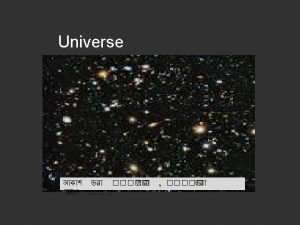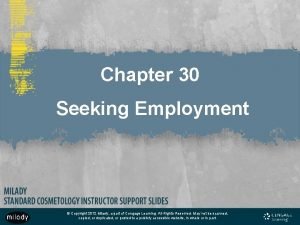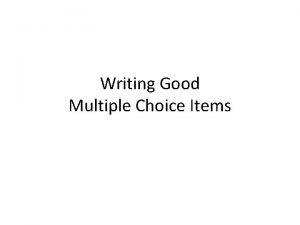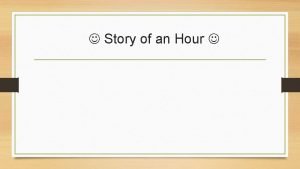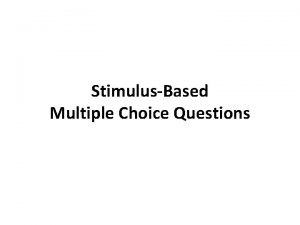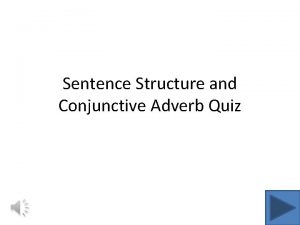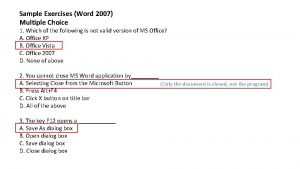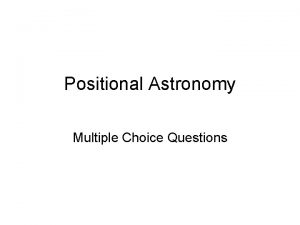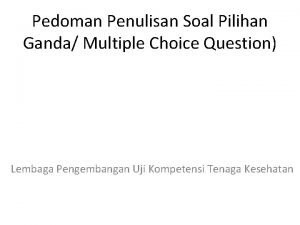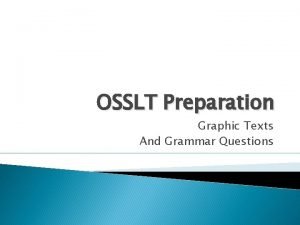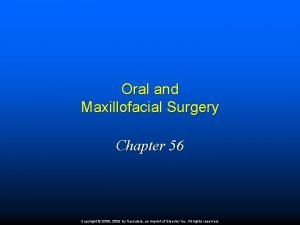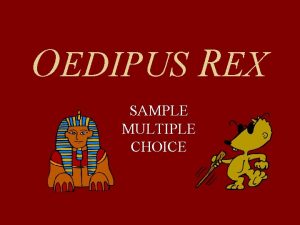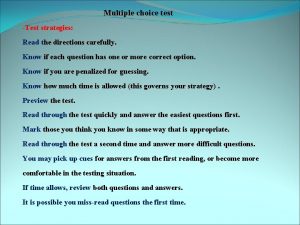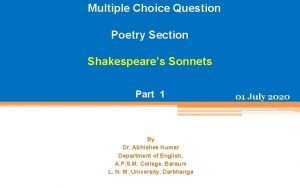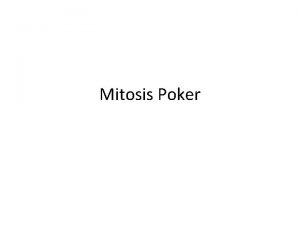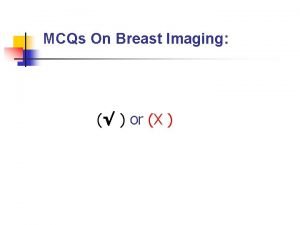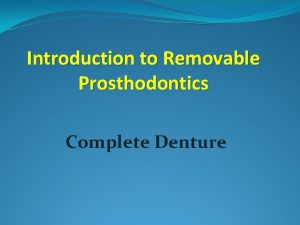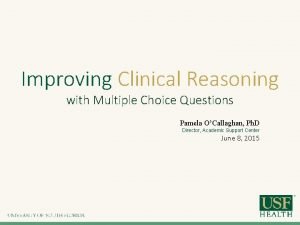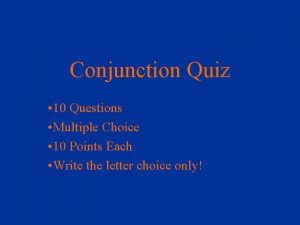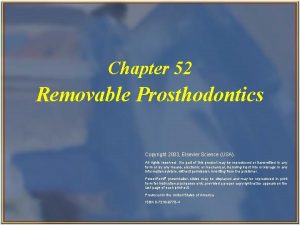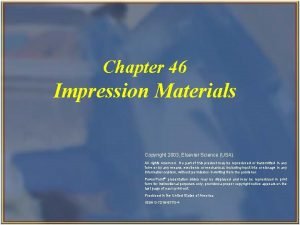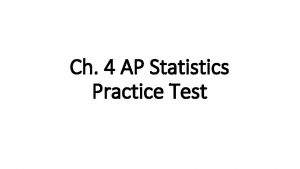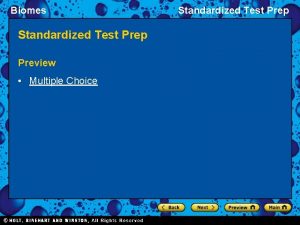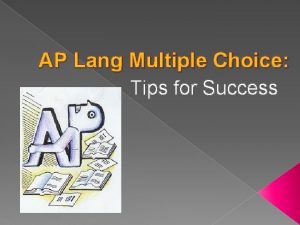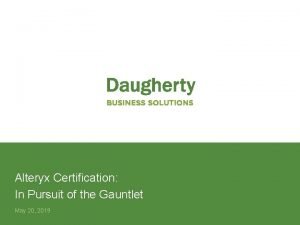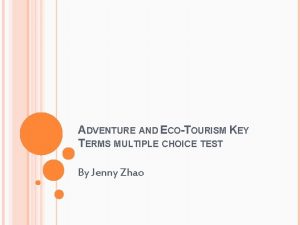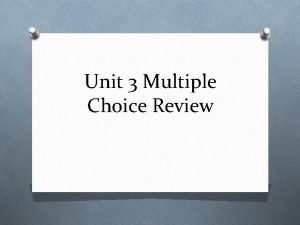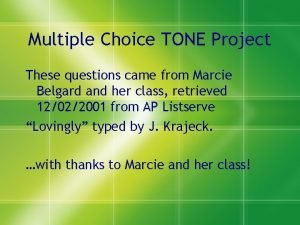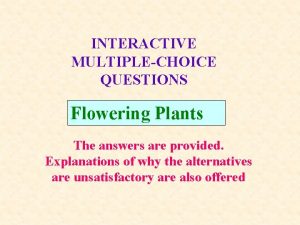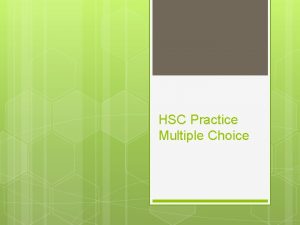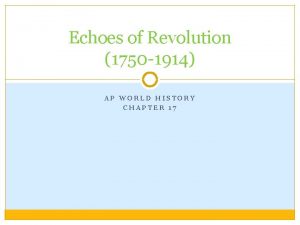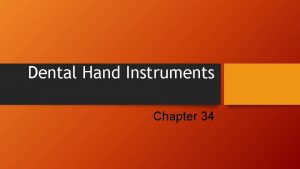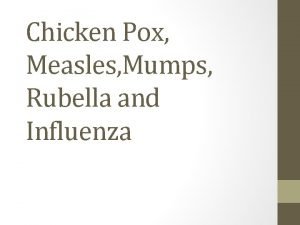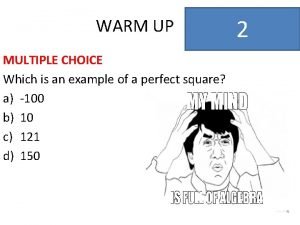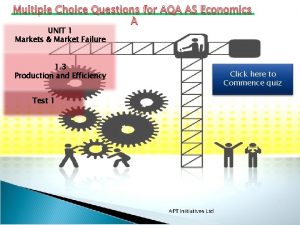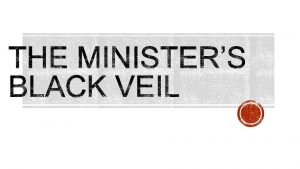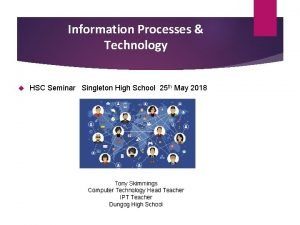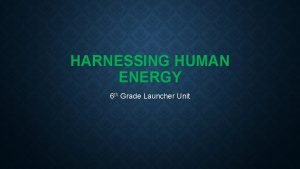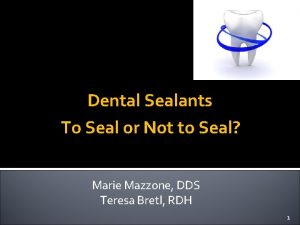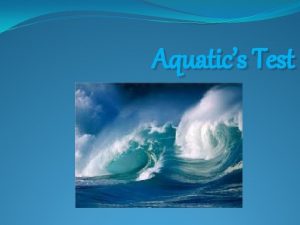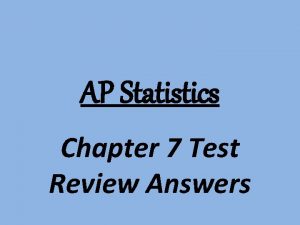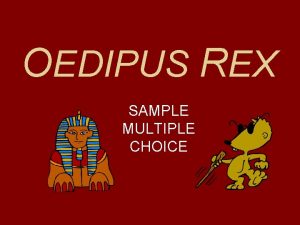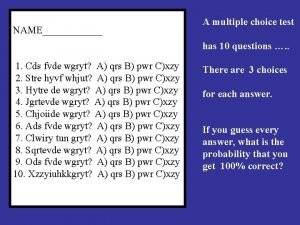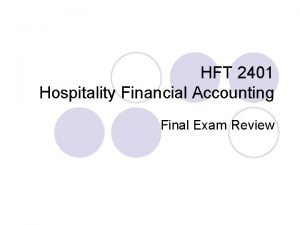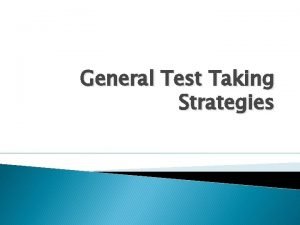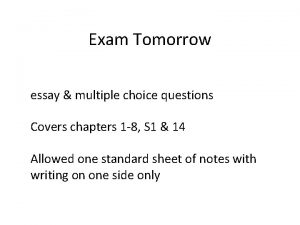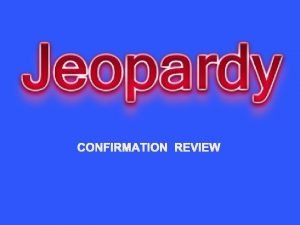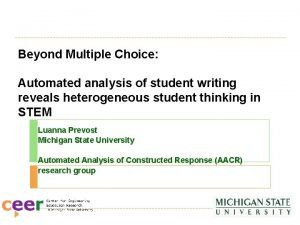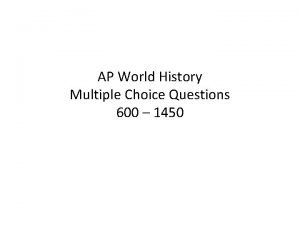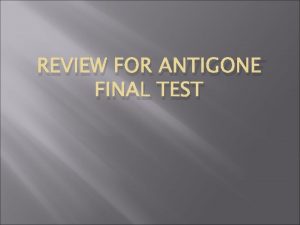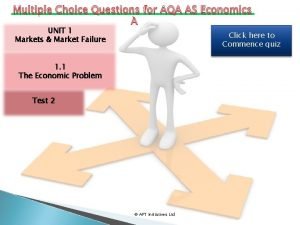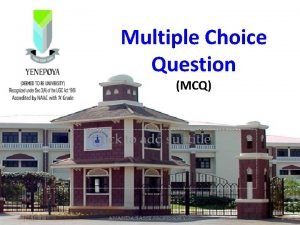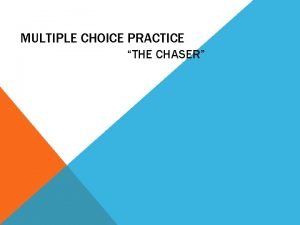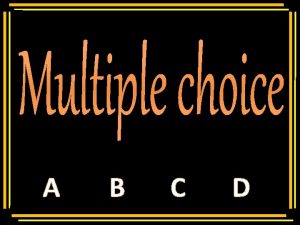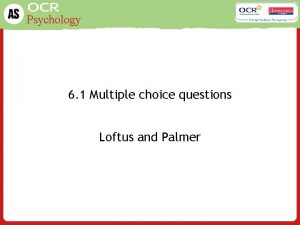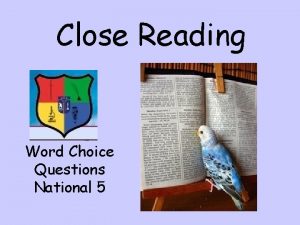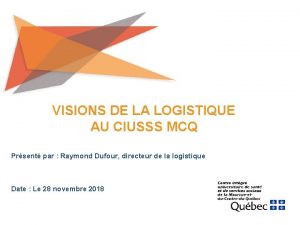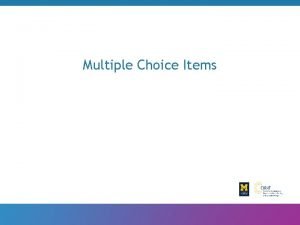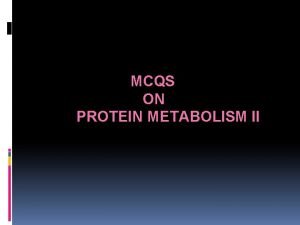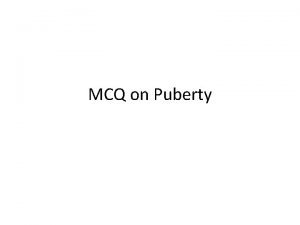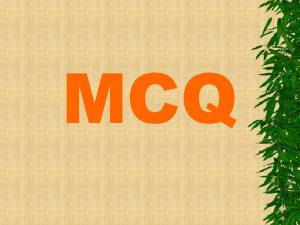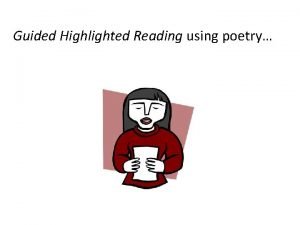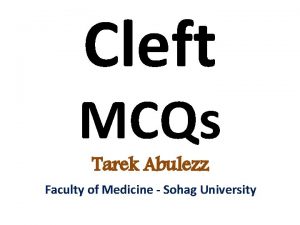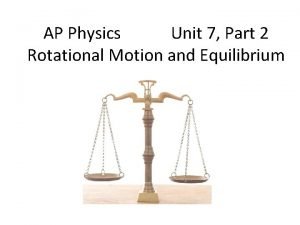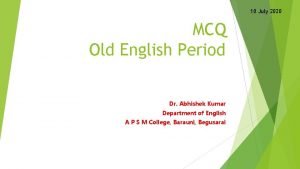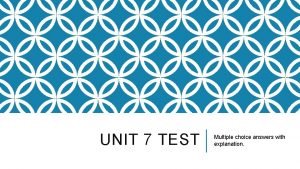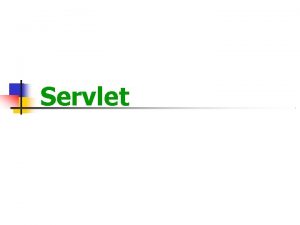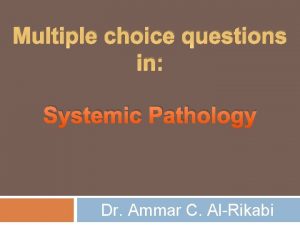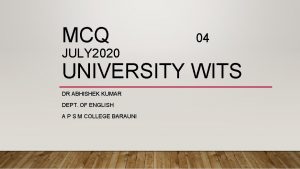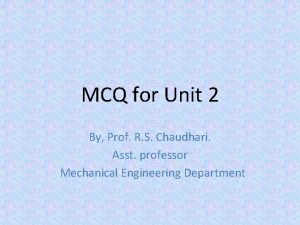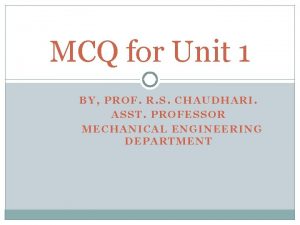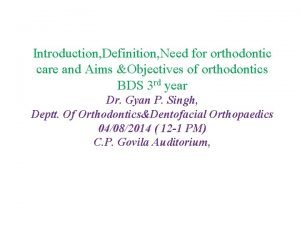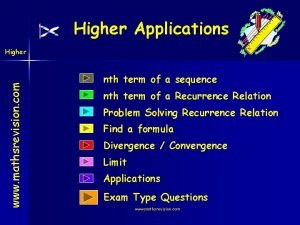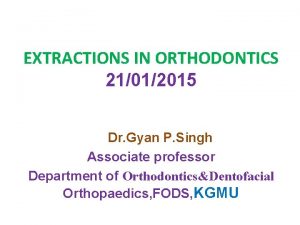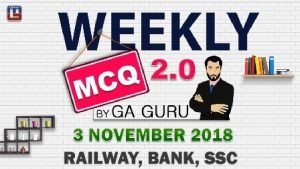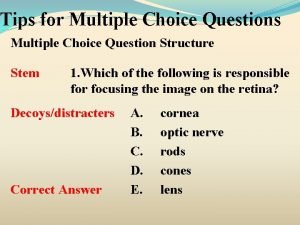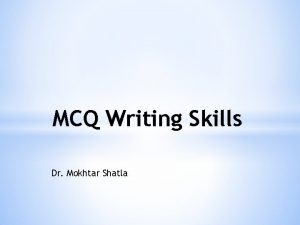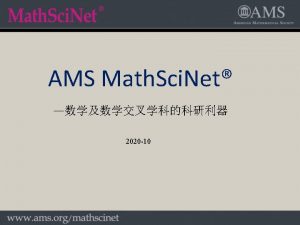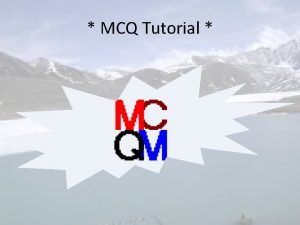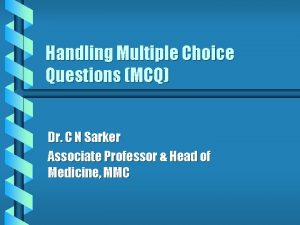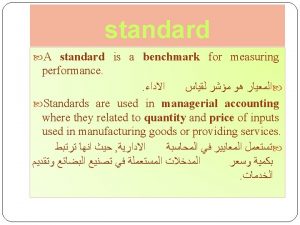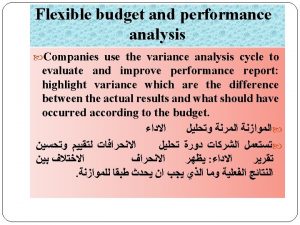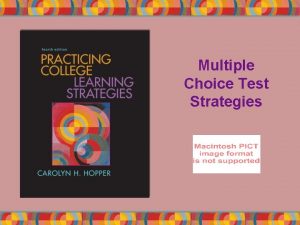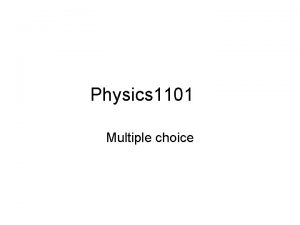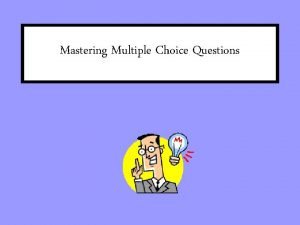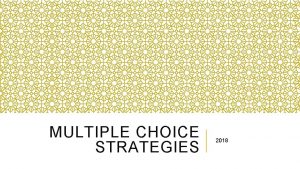Construction of Multiple Choice Question MCQ Prof Tahmina













































































































- Slides: 109


Construction of Multiple Choice Question (MCQ) Prof. Tahmina Begum FCPS, MD, M MEd

Objectives Types of MCQ ¡ Advantages and limitations of MCQ ¡ Components of MCQ ¡ Construction of MCQ ¡

q Multiple choice Questions (MCQs) are fixed response Objective assessment q Widely used in under & post-graduate exam

Why we use MCQs? ¡ ¡ ¡ ¡ Purely objective in scoring & testing Broad coverage of content/ topics Efficient use of time High reliability Test large no. of candidate Ease of analysis Ease of marking - manually/ computer Banking

Limitations ¡ ¡ ¡ ¡ Allow for guessing Difficult & time consuming to construct Extended response Creative thinking can not be Writing ability assessed Longer reading time required Success depends on distracters

Types of MCQ Simple true false ¡ Multiple true-false type ¡ Single best answer ¡ Matching type ¡ Multiple true-false completion type ¡ Assertion and reason ¡ Extended Matching ¡

Multiple True-false type ¡ ¡ Candidate choose more than one response from a list of possible answers/ options Options are related to single topic

Example Microcytic hypochromic anaemia is found in: a) acute haemorrage b) folate deficiency c) iron deficiency Key- c, d, e d) sideroblastic anaemia e) thalassaemia

Components of MCQ (Item) ¡ ¡ ¡ Stem- present a problem/ a clinical scenario or a incomplete statement Option- 5 options should all be possible answer to the question but 1 or > 1 may be correct or true & others are false/ distracters Key is the KEY by which answers are compared as true or false

A Stem ¡A statement (mostly used) e. g. contraindication to use of digoxin includes: ¡ Diagram, graph, lab report ¡ Short description of a problem ¡ Case scenario

Short description of a problem A 30 -year-old lady came with increased frequency & burning sensation during micturation. The likely organism to be found in her urine culture include: a) E. coli b) Salmonella c) Bacteroids fragilis d) Proteus mirabilis e) Mycoplasma

Multiple True false Assess recall of isolated fact ¡ Restriction of choice ¡ Difficult to construct ¡ Guessing & cuing effect ¡

Single Best Answer (SBA) This format consists of a list of possible answers, among which only one is the “Best” ¡ The candidate select Correct/ Best/ Appropriate response from 5 possible answers ¡

Single best answer (SBA) More flexible ¡ Test more than isolated fact ¡ Test higher level of learning (application, problem solving) ¡ Require more time to complete ¡

points to consider Many DO’s & DO NOT’s

DO’s ¡ ¡ ¡ Clear and concise Reading time minimum Specify unit Use only plausible and logical distracters Minimum negatively phrased statements in stem, options Spell out acronyms, abbreviations

DO’s Accurate in grammar & sentence ¡ Continuous with the stem ¡ Use familiar words ¡ Within the syllabus ¡ Important & useful aspect ¡ Link options to each other/homogenous (e. g. all artery, nerve, hormone etc. ) ¡

Options (key & distracters) ¡ ¡ Similar in terms of grammar, length & complexity Homogenous or fall into the same category e. g. risk factors, tests, treatment, artery, nerve, hormone, vitamin etc. The best No. is- 5 Arrange the list of options systematically (chronological, alphabetical, numerical)

Erb’s palsy is characterized by loss of power to: a) b) c) d) e) Abduct the arm at shoulder Adduct the thumb Extend the forearm at elbow Grasp the object by hand Supine the forearm All movements of upper limb Homogenous Alphabetical

Erb’s palsy is characterized by loss of power to: a) b) c) d) e) Abduct the arm at shoulder Constrict the pupil Extend the forearm at elbow Grasp the object by hand Supine the forearm Alphabetical BUT Non homogenous

PKDL is manifested by the following lesion Q 15, III a) Dry scaly lesion b) Erythema in face c) Hepatomegaly d) lichenification e) Maculopapular rash around chin Alphabetical BUT Non homogenous

PKDL is manifested by the following lesion Q 15, III a) Dry scaly lesion b) Erythema in face c) Hypopigmented macule d) lichenification e) Maculopapular rash around chin Alphabetical Homogenous

Bone developed from mesodermal germ layer include Q 07, I a) b) c) d) e) Maxilla Mandible Scapula Ribs Zygomatic bone Alphabetical & Homogenous

a) b) c) d) e) Bone developed from mesodermal germ layer include Q 07, I Femur Maxilla Mandible Scapula Zygomatic bone Alphabetical BUT Non homogenous

Following nerves arises from lumber plexus: a) b) c) d) e) femoral obturator pudendal sciatic superior gluteal All nerves of lower limb Homogenous Alphabetical

Following nerves arise from lumber plexus: a) Femoral nerve b) Median nerve c) Obturator nerve d) Pudendal nerve e) Sciatic nerve Nerves Non Homogenous Alphabetical

PLAN the question Recall Understanding ¡ The learning level Application Clinical judgment problem solving

DO NOT’s/ Avoid ¡ ¡ ¡ Too open /ambiguous term e. g. can / possible/may/sometimes/common/ often/seldom- likely to be true Too absolute term e. g Never / always- tend to be false Should not contain clue to answer Avoid uncommon terminology & abbreviation Avoid double negative

Avoid Implausible item ¡ More than one concept ¡ Incorrect information ¡ Too long statement ¡ Opposite statement in one branch ¡ Avoid clues to correct answer ¡ All or none of the above ¡

Avoid Do not use the question-”which of the following statements are correct? ” The question is unfocused

Q. The risk factor for BPD are… OR, Term. . PT. . . PVR. . . VSD × Avoid using uncommon terminology × Clues as to the number of true or false answer- is/are

The jugular foramen a) b) c) d) e) The accessory nerve passes Transmits inf. Petrosal sinus Is a foramen in occipital bone Is about 0. 5 cm in diameter Lies lateral to hypoglossal nerve × a –not gramatically continuous √ a) Gives passage to accessory nerve

The respiratory bronchiole a) b) c) d) e) Bears small alveoli Lined by non ciliated cuboidal epithelium Have cartilaginous rings in their wall Have mucous secreting goblet cells Supplied by bronchial arteries b, e- are not grammatically continuous with stem

Q. The third part of the duodenuma) b) c) d) e) Is ant. to uncinate process of pancreas Is ant. To common bile duct Is ant. to right ureter Is ant. to sup. mesenteric artery Is ant. to inf. mesenteric vein Q. The third part of the duodenum is anterior to a) b) c) d) e) Uncinate process of pancreas Common bile duct Right ureter Sup. mesenteric artery Inf. mesenteric vein ** Common element in the response should be included in the stem

Cont’ ¡ ¡ ¡ Wt loss is sometimes found in patient with thyrotoxicosis Wt loss is found in a few patient with thyrotoxicosis Wt loss is commonly found in thyrotoxicosis × Sometimes/ a few/ commonly difficult to interpret √ wt loss is found in 20% of patient with thyrotoxicosis Try to be quantitative, rather than qualitative

Cont’ a) b) Haemophillia never occur in female Hepatomegaly is always found in PEM × Avoid absolute term ‘never’/ ‘always’ the answer is usually false Malarial parasite often found in blood film during febrile phase × ambiguous term ‘often’ a)

The following features are not unusual in DKA a) b) c) d) Hypoventilation Ketonuria Unconsciousness ------- × Avoid double negative

Cont’ Q. The diencephalona) Is involved in the regulation of thirst & hunger but not of movement OR Q. The ECG & serum cholesterol are measure of the peripheral effect of thyroid hormone × Avoid double statement One part may be correct & other is wrong

Q. SIADH is charecterized bya. Hypernatremia b. Hyponatremia c. Hypertension d. ………………. . × Avoid opposite statements in two options

EXAMPLE

Blood brain barrier is formed bya) b) c) d) e) Arachnoid matter Basement membrane Capillary endothelium Pia matter Perivascular foot plate of astrocyte

Oxy hemoglobin dissociation curve is influenced bya) b) c) d) e) Altitude Conc. Of 2, 3 DPG Nature of globin chain p. H Respiratory drive Key a, b, e

Q. Insulin acts on liver by increasinga) b) c) d) e) Entry of glucose into liver cells Gluconeogenesis Glycogen synthesis Ketogenesis Key: a, c, e Protein synthesis

The X chromosome of the Barr body Q 12, I a) b) c) d) e) Is completely inactive Consists mostly of heterochromatin Can be identified in the 2 cell embryo Can be seen by light microscopy Is seen in some cases of Turner’s syndrome

Clinical examples of type II hypersensitivity reaction are: a) b) c) d) e) Graves disease Myasthenia gravis Post streptococcal GN Serum sickness Tuberculin reaction Key- a, b

Ig E may be increased in the following Q 15, III A) B) C) D) E) Chronic eczema Childhood dermatitis Drug eruption Psoriasis Lichen planus

Angiogenesis is a process that affects some physiological process Q 04, Paper III a) b) c) d) e) Wound healing Chronic inflammation Menstruation Diabetic retinopathy Regeneration

Paralysis of oculomotor nerve causes: Q 10, Paper-I a) b) c) d) e) Ptosis Constriction of pupil Loss of consensual light reflex Displacement of eyeball outward & downward Upward displacement of angle of mouth

Filariasis : Q 24. paper III a) b) c) d) e) Is a tropical disease Transmitted by Anophelis mosquitoes Adult worm lives in lymphatics and blood Microfilaria is produced by adult male or female worm Acute lymphangitis is caused by toxin released by adult worm

Male external genitalia develops under the influence of: Q 4, I a) b) c) d) e) Anti-mullerian hormone Testosterone dihydrotestosterone 5 α reductase Growth hormone

Complications of GER disease include, Q 31, III a) b) c) d) e) Oesophagitis Oesophageal mucosal erosion & haemorrhage Oesophageal mucosal atrophy Metastatic changes in esophageal mucosa Hypertrophy & hyperplasia of mucosa

Presenting features of HIV infection include- Q-15, III a) b) c) d) e) Hairy leucoplakia Atypical pneumonia Neutrophilia Ornycomycosis Candidiasis & cryptosporidiasis

After birth, proximal portion of umbilical arteries persists as the: Q 21, I a) b) c) d) e) Coeliac artery Superior mesenteric artery Inferior mesenteric artey Internal iliac artery Right subclavian artery

Following statements are true regarding ovaries Q-6, I a) b) c) d) e) Multiple follicles are placed peripherally in polycystic ovarian disease Are attached to the broad ligaments by ovarian ligaments Size of ovaries change according to ages Have clearly defined cortex and medulla Both the ovaries receive blood supply from the abdominal aorta

In acute inflammation, Q 5, III a) b) c) d) e) Vasodiladation is mediated by thromboxane A 2 Complements are produced from leucocyte Pain is mediated by prostaglandin & bradykinin Fever is mediated by IL-1, TNF & prostaglandin Alternative pathway of complement activation occur

The liver and pregnancy, Q 16, I a) b) c) d) e) Liver is the largest gland of the body, it weighs 1500 gm The patient complains of hypochondriac pain in pre-eclamsia is due to subcapsular haemorrhage Cholestasis of pregnancy recurs in subsequent pregnancies Acute fatty liver in pregnancy is a grave condition Viral hepatitis in pregnancy may results hepatic failure

In Orthopedic practice (Q 32, paper III) a) b) c) d) e) Acute osteomyelitis is mostly caused by Staphylococcus Acute osteomyelitis is diagnosed by digital x-ray Osteosarcoma usually occurs between 1025 years Giant cell tumour of bone is commoner in growing ends of long bones More than 80% of all bone metastasis originate from breast, lungs, prostate, thyroid or kidney

SINGLE BEST ANSWER (SBA)

Single Best Answer (SBA) This format consists of a list of possible answers, among which only one is the “Best” and the remaining are inferior but not incorrect ¡ The candidate select Correct/ Best/ Appropriate response from 5 possible answers ¡

Components of SBA ¡ ¡ Stem- present a problem/ a clinical scenario or a incomplete statement Lead in- short question that the candidate is asked to answer Option- 5 options should all be possible answer to the question but one is the best for SBA Correct answer is KEY, others are distracters

Example: Structure of SBA A 5 -year-old boy presented with rose coloured, pruritic, pigmented macules, papules and nodules all over the body suggestive of urticaria pigmentosa Which is the most likely pathogenesis involved in this case? a) b) c) d) e) Neoplastic proliferation of mast cell Local accumulation of mast cells Systemic accumulation of mast cells Oncogenic mutation of mast cells Cytokine proliferation of mast cells Key b? ? Stem Lead in O p T I O n s

Example: Structure of SBA A 22 -year-old man presented with headache & dimness of vision. On perimetry you have found bi-temporal hemi-anopia Where is the most probable site of lesion? a) b) c) d) e) Optic nerve Optic chiasma Optic tract Key-b Lateral geniculate body Occipital cortex Stem Lead in O p T I O n s

Item One full question

Stem Present a problem/ a clinical scenario or a incomplete statement

Lead In Short question that the candidate is asked to answer

Options Key- the correct answer ¡ Distracters- options other than key ¡

The distracters Correct or near correct statements but do not answer the question ¡ Should differ from key, not so close to the correct answer that may confuse students ¡ Plausible & attractive alternatives of answer ¡ Sufficient no. to reduce guessing ¡ Should be of similar length ¡

Options (key & distracters) ¡ ¡ Similar in terms of grammar, length & complexity Homogenous or fall into the same category e. g. signs, diagnosis, risk factors, tests, treatment, artery, nerve, hormone, vitamin etc. The best No. is- 5 Arrange the list of options systematically (chronological, alphabetical, numerical)

Example: Structure of SBA A 32 yr old woman presents with 2 wks H/O diarrhoea, sweating & restlessness. O/E her BP-150/60, pulse-110, thyroid is diffusely enlarged, firm & tender. Which one of the following tests will help to establish the etilogy of her disease? a) Antithyroid antibody b) Free triiodothyronine c) Free thyroxine d) Radioactive iodine uptake Key e) Thyroid stimulating hormone assay Stem Lead in O p T I O n s

Example: Structure of SBA A 4 -year-old boy presented with pain & swelling of right knee joint. He had similar problem 6 months back following trauma Which one of the following tests will help you to confirm the etiology of his disease? a) b) c) d) e) Activated partial thromboplastin time (APTT) Clotting time Factor VIII assay Key Protrombin time Thrombin time Stem Lead in O p T I O n s

Item on neuropathy Stem: An 25 - year old lady has been diagnosed as a case of PT and treated with 4 FDC. After 3 weeks of treatment, patient developed an abnormal sensation in his foot. Lead In: Which of the followings is deficient in this case? a. Cobalamin b. Folic acid key- c Alphabetical c. pyridoxin And homogenous d. Riboflavin e. thiamin

Item on neuropathy Stem: An 25 - year old gentleman has been diagnosed as a case of PT and treated with 4 FDC. After 3 weeks of treatment, patient developed an abnormal sensation in his foot. Lead In: Which of the followings is deficient in this case? a. Cobalamin b. pyridoxin Alphabetical BUT c. Riboflavin Non homogenous d. thiamin e. xinc Key: b

Stem: In an unconscious patient following head injury, you want to assess the level of consciousness Lead In: which of the following sign will allow you to assess the level of consciousness? a) Abdominal reflex b) Cough reflex Alphabetic c) Gag reflex Homogenous d) Planter reflex e) Pupillary reflex

Statement: A spirometer can be used to measure directly the: Q 41, III a) b) c) d) e) Functional residual capacity Inspiratory capacity Physiological dead space Residual volume Total lung capacity

Statement: Lumber disc prolapse is common in: Q 43, III a) b) c) d) e) L 1, 2 L 2, 3 L 3, 4 L 4, 5 L 5, S 1

Lead In: Which of the following is not an organ specific auto-immune disease? : Q 41, III a) b) c) d) e) Hashimoto’s thyroiditis Juvenile diabetes mellitus Addison’s disease Rheumatoid arthritis Pernicious anaemia

Stem: An-18 -year-old female presented with polycystic ovary syndrome & metformin was prescribed Lead In: What is the most important pharmacological action of metformin in this case? Options: a) Increasing gluconeogenesis b) Increasing insulin level c) Increasing LH level d) Increasing oestradiol level e) Increasing peripheral glucose uptake

Guidelines (Cont’) � Make sure that the scenario contains all relevant information for the student to reach the correct answer, but is reasonably short (not more than 50 words) � Identify and mark five options from the list, which though not correct, are quite close to the correct answer and are plausible

Eg. Steps in developing SBA in short ¡ ¡ ¡ ¡ Specialty: Paediatrics System: Haematology Choose a theme (e. g. purpura, gum bleeding, pallor, lymphadenopathy, splenomegaly, bone pain etc. ) Choose a sub-theme (S/S, risk factors, diagnosis, investigation, treatment, complication) Make a list of 6 -10 homologous options related to theme & sub-theme (brief, similar length) Select one option with an asterisk * Write a case scenario Reduce option list to 5 (alphabetical)

Option list 1. 2. 3. 4. 5. 6. 7. S. Iron S. ferritin S. Iron binding capacity Bone marrow study Coomb’s test Hb electrophoresis * Reticulocyte count

Clinical case scenario A 5 year old boy attended in OPD with complaints of gradual pallor for 3 years. O/E he was found moderately pale with hepatosplenomegaly. His Hb% was 7 gm% & PBF showed microcytic hypochromic picture with fair number of target cell Lead in: What investigation you want to do to confirm the dx?

Option list a. b. c. d. e. Bone marrow study Coomb’s test Hb electrophoresis Reticulocyte count S. ferritin key- c

Scenario: A newborn baby delivered by C/S for breech presentation, on routine check up, his arm was found in a position of adduction and internal rotation with pronation of forearm Lead in: Which of the peripheral nerves are injured in this case? Options: a) 3 rd, 4 th and 5 th cervical b) 5 th and 6 th cervical c) 7 th and 8 th cervical d) 7 th , 8 th cervical and 1 st thoracic e) 1 st and 2 nd thoracic Key- c

Stem: In long standing cases of lesion of median nerve at wrist level, you have found wasting of thenar eminence Lead In: Wasting of which muscle is responsible in this case? Options: a) Flexor pollicis b) Abductor pollicis brevis c) Opponens pollicis d) Adductor pollicis e) Flexor pollicis brevis

Stem: A 32 - year-old gentleman following road traffic accident was admitted for haemorrhagic shock Lead In: What would be the body response to compensate his condition? Options: a) Vasodilatation b) Bradycardia c) Increased secretion of glucocorticoids d) Increased secretion of adrenaline e) Decreased secretion of vasopressin

SBA: Pharmacology Item A patient in the emergency department cannot remember which “heart drug” he is taking. He says he has “ringing in his ears. ” His heart rate is greater than 80/min. The ECG shows prolonged PR and QRS intervals. Which of the following drugs has the patient most likely been taking? a. Digoxin b. Lidocaine c. Phenytoin d. Propranolol e. Quinidine Key: e

Theme: Penicillin Sub theme: Mechanism of action Stem: You want to prescribe penicillin for a infected skin lesion Lead in: How does the penicillin works? Optons: Inhibition ofa. DNA synthesis b. Fatty acid c. Nucleutide synthesis d. Protein sysnthesis e. RNA synthesis

SBA: Pharmacology Item Theme: Anti TB Sub theme: side effect Scenario: A patient came to out-patient department with a complaints of abnormal sensation in his legs. He has been taking anti TB drugs for 1 month. Lead in: Which of the following drugs is responsible in this case? Options: a. ethambutal b. isoniazide c. pyrazinamide Key: b d. rifampicin e. streptomycin

System: Renal System Theme: nephrotic syndrome Sub-theme Pathological change Scenario: A 18 -year-old male presented with generalised oedema and massive proteinuria. He has no hypertension and haematuria Lead in: Which is the most likely pathological change found in the kidney in this case? Options: a)Deposition of Ig. A in messangium b)Focal segmental glomerulosclerosis c)Effacement of epithelial foot process d)Messangeal proliferation e)Tubular atrophy

Scenario: A 8 year old boy developed respiratory distress who had puffiness of the face, scanty high colored urine and hypertension Lead in: Select the diuretic that should be administered for initial management in this case Options: a) Ameloride b) Frusemide c) Mannitol d) Spiranolactone e) Thiazide Key: b

System: Nervous System Theme: Meningitis Sub-theme Causative agent A 2 year old girl attended at emergency room with fever, several attack of convulsion & poor feeding. O/E she had neck rigidity & purpuric spots over the back. Lead in: What organism is responsible for this illness? Options: a) Group B Strepto b) H. influenzae c) Klebsiella d) N. meningitidis e) S. pneumonae key- d

SBA: Factual Recall of Knowledge The candidate repeats previously learned material by recalling facts, terms, and basic concepts Example: A branch of which cranial nerve supplies the vocal cords ? A. Optic B. Trochlear C. Abducens D. Vestibulocochlear E. Vagus

SBA: Application The candidate solves problems by applying acquired knowledge, facts, techniques and rules in a clinically relevant situation Example: A 65 year-old man has difficulty rising from a seated position and straightening his trunk, but he has no difficulty flexing his leg. Which of the following muscles is affected here? A. Gluteus maximus B. Gluteus minimus C. Hamstrings D. Iliopsoas E. Obturator internus

Stem: A 42 -year old man presents with non-bilious persistent vomiting after each feed. O/E he was found dehydrated. Lab reports revealed- p. H- 7. 42, Na- 132, K- 1. 5, Cl- 84, HCO 3 -32 Lead In: which acid- base abnormality is found in this case? a) Compensated respiratory acidosis b) Metabolic acidosis c) Metabolic alkalosis d) Respiratoty alkalosis key- c e) Respiratory acidosis

Stem: A 50 - year old patient is on mechanical ventilation after a road traffic accident in ICU. The patient is declared as brain dead. Lead In: Which one of the following features is essential to declare brain death? a) Absent spinal reflex b) Dilated pupil c) Flat ECG d) Hypothermia e) No respiration when PCO 2 exceeds 7 Kpa

Stem: -------Lead In: Which muscle paralysis causes winged scapula? a) Supraspinatus b) Infraspinatus c) Levator scapularis d) Trapezius e) Serratus anterior

Template for Clinical Item ¢ Stem: (Components of a Patient Vignette): Age and gender (“ 42 -year-old woman”) l Site of care (“comes to the emergency department”) l Presenting complaint (“because of headache”) l Duration (“that has continued for 2 days”) l Past history (may not be relevant) l Physical findings: l Results of diagnostic studies; l Initial Treatment, Subsequent Findings, Etc. ¢ Lead-in: What is the most appropriate management? ¢ Options: (List management options) l

Anything TOPIC can form the basis for options in SBA or multiple choice ¡ ¡ ¡ ¡ ¡ Arteries Nerves Muscles Cell components Organs Joints Body fluid DNA analysis ¡ ¡ ¡ ¡ ¡ Hormones Enzymes Neurotransmitters Amino acids Vitamins/ minerals Blood components Metabolic defects Electrolyte abnormalities Hemodynamics

Topics ¡ ¡ ¡ ¡ Causative agents Pathological process Cytokines Immune disorders Vaccines Drugs / side effects Toxic agents Screening tests ¡ ¡ ¡ ¡ Physical signs/ symptoms Diagnoses Crucial investigations Lab studies Initial management steps Management alternatives Risk factors

Write the question 3 Cs Correct Clear Concise

Always consider level of learning

Levels of cognitive domain Evaluation Synthesis Analysis Application Comprehension Recall

Nice to know Useful to know Must know

Test matrix (blueprint) Competence categories History taking Physical Exam X-Ray Data interpretation Insrument Write prescription Communicatio n & Patient Education CVS RS Neuro GI GU/Renal MSS Endo/Metab Haem/Oncology Other

Test matrix (blueprint) Competence categories History taking Physical Exam X-Ray Data interpretation Insrument Write prescription Communicatio n & Patient Education CVS RS Neuro GI GU/Renal MSS Endo/Metab Haem/Oncology Other

Take Home Points • Each item should focus on an important & concept and must be specific • Each item should assess application of knowledge, not recall of an isolated fact • The stem of the item must pose a clear question, and it should be possible to arrive at the answer with the options covered • All options should be homogeneous

Thank You for your Attention!! Any Comments or Questions? ?

Let’s start a new journey !!
 Prof. tahmina begum
Prof. tahmina begum Milady chapter 30 pdf
Milady chapter 30 pdf Costas leveled questions examples
Costas leveled questions examples Good choice or bad choice
Good choice or bad choice How to write multiple choice questions
How to write multiple choice questions Binary choice items
Binary choice items Merchant of venice act 4 scene 1
Merchant of venice act 4 scene 1 Story of an hour multiple choice questions
Story of an hour multiple choice questions Stimulus based multiple choice questions
Stimulus based multiple choice questions Conjunctive adverb quiz
Conjunctive adverb quiz How to create multiple choice questions in word 2007
How to create multiple choice questions in word 2007 Recursion apcs
Recursion apcs Multiple choice questions for primary students
Multiple choice questions for primary students Ap lit practice mcq
Ap lit practice mcq Astronomy questions and answers multiple choice
Astronomy questions and answers multiple choice What is the main purpose of persuasive paragraph mcq
What is the main purpose of persuasive paragraph mcq Konvergensi option adalah
Konvergensi option adalah Osslt grammar practice with answers
Osslt grammar practice with answers Chapter 56 oral and maxillofacial surgery multiple choice
Chapter 56 oral and maxillofacial surgery multiple choice The plot of oedipus deals mainly with
The plot of oedipus deals mainly with Direction for multiple choice test
Direction for multiple choice test Multiple choice questions on shakespeare sonnets
Multiple choice questions on shakespeare sonnets Mitosis
Mitosis Mcq on breast anatomy
Mcq on breast anatomy Chapter 52 removable prosthodontics multiple choice
Chapter 52 removable prosthodontics multiple choice Pamela mcq
Pamela mcq Growth mindset multiple choice questions
Growth mindset multiple choice questions Coordinating conjunction quiz
Coordinating conjunction quiz Chapter 52 removable prosthodontics multiple choice
Chapter 52 removable prosthodontics multiple choice Chapter 46 impression materials multiple choice
Chapter 46 impression materials multiple choice Sign chapter 37
Sign chapter 37 When we take a census we attempt to collect data from
When we take a census we attempt to collect data from Biomes multiple choice questions with answers
Biomes multiple choice questions with answers Ap lang multiple choice questions
Ap lang multiple choice questions Alteryx case sensitive
Alteryx case sensitive Multiple choice questions on sustainable tourism
Multiple choice questions on sustainable tourism Which command is used to set terminal io characteristic
Which command is used to set terminal io characteristic Polynomials multiple choice test doc
Polynomials multiple choice test doc Tone multiple choice questions
Tone multiple choice questions Multiple choice questions on photoelectric effect
Multiple choice questions on photoelectric effect Multiple choice questions on flowering plants
Multiple choice questions on flowering plants Hsc multiple choice practice
Hsc multiple choice practice Ap world history chapter 17 multiple choice questions
Ap world history chapter 17 multiple choice questions Dental accessory instruments
Dental accessory instruments Multiple choice questions on chicken pox
Multiple choice questions on chicken pox Quadratic equations mcq
Quadratic equations mcq Multiple choice comma quiz
Multiple choice comma quiz Hamlet multiple choice test
Hamlet multiple choice test Multiple choice questions on poetic devices
Multiple choice questions on poetic devices Aqa economics multiple choice questions
Aqa economics multiple choice questions Answer
Answer Data dictionary ipt
Data dictionary ipt Harnessing human energy vocabulary
Harnessing human energy vocabulary Dna structure and replication packet answer key
Dna structure and replication packet answer key Chapter 59 dental sealants multiple choice
Chapter 59 dental sealants multiple choice Multiple choice choose the best answer
Multiple choice choose the best answer Ap stats chapter 7 review answers
Ap stats chapter 7 review answers Math multiple choice test taking strategies
Math multiple choice test taking strategies Oedipus rex mcq
Oedipus rex mcq A multiple choice test has 10 questions
A multiple choice test has 10 questions Mcq on mycobacterium leprae
Mcq on mycobacterium leprae Financial accounting final exam multiple choice
Financial accounting final exam multiple choice Multiple choice questions on prokaryotes and eukaryotes
Multiple choice questions on prokaryotes and eukaryotes Multiple choice questions
Multiple choice questions Eucharist multiple choice questions
Eucharist multiple choice questions Beyond multiple choice
Beyond multiple choice Multiple choice questions
Multiple choice questions Antigone final test review
Antigone final test review Chapter 5 elasticity and its application multiple choice
Chapter 5 elasticity and its application multiple choice Economics multiple choice questions aqa
Economics multiple choice questions aqa Examples of multiple choice questions
Examples of multiple choice questions The chaser questions and answers
The chaser questions and answers Multiple choice a b c d
Multiple choice a b c d Multiple choice pencil
Multiple choice pencil Silk road multiple choice questions
Silk road multiple choice questions Positive psychology multiple choice questions
Positive psychology multiple choice questions Pacemaker multiple choice questions
Pacemaker multiple choice questions Baseline
Baseline Advantages and disadvantages of mimd
Advantages and disadvantages of mimd Word choice formula
Word choice formula Present simple question words
Present simple question words Closed questions
Closed questions Contoh open question
Contoh open question Factors isolating questions
Factors isolating questions Direct vs indirect questions
Direct vs indirect questions Compelling vs supporting questions
Compelling vs supporting questions Compelling question examples
Compelling question examples Appro buanderie
Appro buanderie What is mcq
What is mcq The coenzyme is mcq
The coenzyme is mcq Mcq on puberty
Mcq on puberty Batter my heart mcq
Batter my heart mcq Mcq on sheet metal forming
Mcq on sheet metal forming They looked like frightened beads
They looked like frightened beads In go kiss the world the narrator's father was
In go kiss the world the narrator's father was Cleft lip and palate mcq
Cleft lip and palate mcq Ap physics unit 7 mcq
Ap physics unit 7 mcq Mcq on old english period
Mcq on old english period Prigravida
Prigravida Unit 7 ap lit mcq
Unit 7 ap lit mcq Servlet 4
Servlet 4 Systemic pathology mcqs
Systemic pathology mcqs University wits mcq
University wits mcq Bifilar oscillation is the example of mcq
Bifilar oscillation is the example of mcq Mcq on brakes and dynamometer
Mcq on brakes and dynamometer Which of the following machine is portable mcq
Which of the following machine is portable mcq Jackson's triad orthodontics
Jackson's triad orthodontics Un - 10un-1 +9un-2-0 find out the roots?
Un - 10un-1 +9un-2-0 find out the roots? Jarabak ratio
Jarabak ratio Faraday's law mcq
Faraday's law mcq
